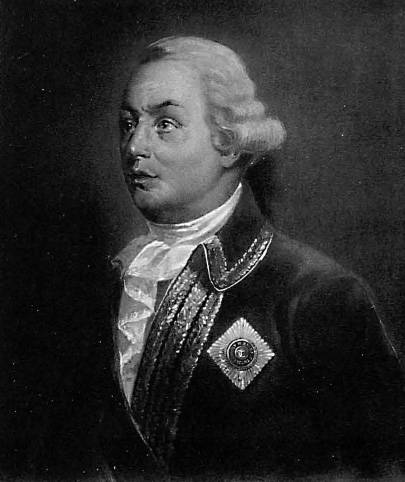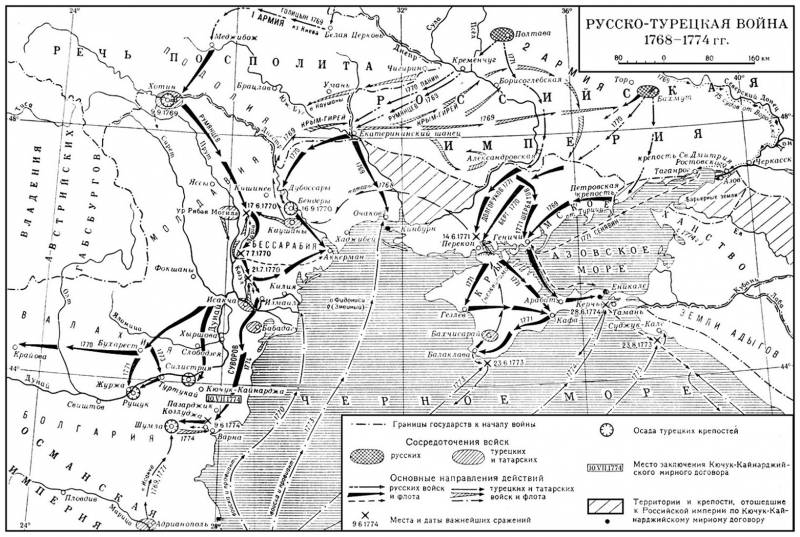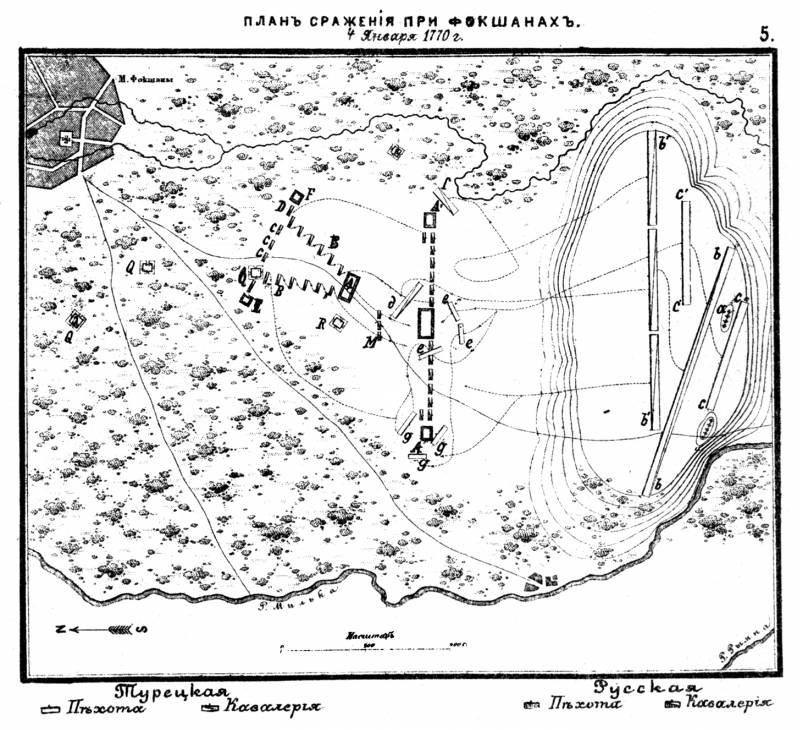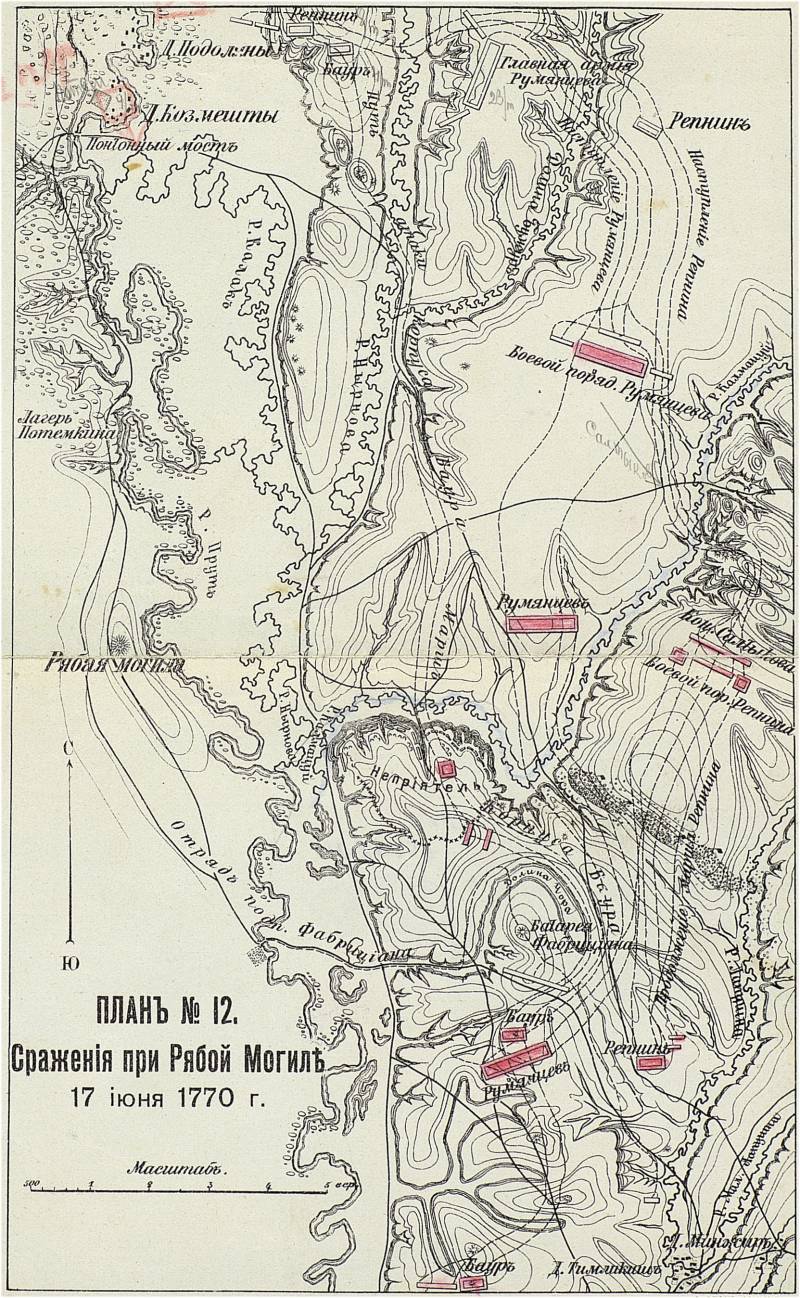The defeat of the Turkish-Tatar army at the Ryaba Graves

250 years ago, on June 17, 1770, the Russian army under the command of Rumyantsev defeated the superior Turkish-Tatar forces at the Ryaba Graves.
prehistory
The Russo-Turkish war of 1768-1774 was caused by the desire of the Ports to maintain their positions in the Northern Black Sea region. Constantinople sought to prevent the Russians from gaining a foothold in the Black Sea and pushing them deeper into the continent. Turkey was pushed by France. Paris supported the Polish Confederates, who fought against their king Stanislav Ponyatovsky and Russia. The reason for the war was a border incident in the town of Balta.
Turkey started the war, counting on the support of France, Austria's friendly neutrality and alliance with the Polish Confederates. The Ottomans hoped, together with the Poles, to capture Kiev, restoring the Commonwealth within the borders of the XNUMXth century. Second Turkish Army supported fleet had to take possession of Azov and Taganrog. The Crimean horde acted in alliance with the Turks. Russian troops were led by Golitsyn and Rumyantsev. The remainder of 1768 passed in the military preparations of the two powers.
1769 Campaign
During the campaign of 1769, at the beginning of the year, Rumyantsev repelled the invasion of the Turkish-Tatar forces in Ukraine, strengthened the garrisons of Azov and Taganrog. Moldova rebelled against the Ottomans and asked for Russian citizenship. However, Golitsyn’s army, instead of going to Iasi, in April was bogged down by Khotin and was unable to take the fortress. Then, due to food shortages, the prince moved to Podolia, at which time the Turks crushed the uprising in Bessarabia. The great vizier acted listlessly, like Golitsyn. At first I wanted to join the Poles, but they did not want the appearance in Poland of a huge horde of such allies. Then the vizier began moving to Novorossia, against Rumyantsev. However, under the influence of rumors that Rumyantsev successfully distributed, the vizier overestimated the forces of the Russian army and did not dare to force the Dniester, returned to Prut. The main forces of the Turkish army stood in the area of the Ryaba Mogila. Vizier sent to Khotyn seraskira Moldavanchi Pasha.
Catherine II was outraged by the passivity of Golitsyn and demanded to take Khotin. In late June, Golitsyn’s army again went to Khotin. Golitsyn’s troops captured the Turkish-Tatar forces in several skirmishes. However, when large enemy formations appeared under the command of the seraskir Moldavanchi Pasha and the Crimean Khan Devlet-Girey, Golitsyn again lifted the siege and retreated beyond the Dniester. The commander of the 1st Army believed that he had solved the main task - to distract the enemy from New Russia. Golitsyn adhered to the school of maneuver warfare. Like, in war, the main thing is not battles, but maneuvers. St. Petersburg was very annoyed by his actions. And the Prussian king Frederick II, when he found out about this event, burst out laughing and said:
The passivity of the vizier and his theft on a particularly large scale caused discontent of Istanbul. The new commander in chief was appointed Moldavanchi Pasha. The new vizier received orders to launch an offensive and occupy Podolia. The offensive ended disastrously for the Turkish army. At the end of August, 80 thousand Moldavanchi Ali Pasha’s army crossed the Dniester, but Golitsyn’s troops threw the enemy into the river. In early September, the Turkish corps crossed the Dniester to collect food and fodder and was completely destroyed. Military failure, the threat of hunger and disease completely demoralized the Turkish army, which mainly consisted of an irregular militia and Tatar cavalry. Almost all the troops deserted. The vizier himself was nearly killed. The 100th Turkish army dispersed without a fight. There remained only a strong garrison in Bender and troops in the Danube fortresses, as well as the Crimean Tatar horde in Kaushany.
Golitsyn did not use the extremely favorable situation to complete the military campaign in favor of Russia. He only in September occupied without a fight the Turks left Khotin. Then again, for the third time, he led the army beyond the Dniester. Catherine's patience snapped, she recalled the prince from the army. The first army was headed by Rumyantsev, he transferred the 1nd army to Panin. Rumyantsev arrived in the army at the end of October. He moved the 2th Moldavian corps of General Stofeln (mainly the cavalry) over the Dniester and the Prut. Stofeln acted energetically and decisively. In November, he occupied Moldova and most of Wallachia. Russian troops occupied Falchi, Galati and Bucharest. At this time, Rumyantsev brought the army in order.
1770 Campaign
In winter, fighting continued. The Turkish-Tatar troops, taking advantage of the small number and dispersal of forces of the Moldavian corps, tried to go on the counterattack. In December 1769, 10 thousand the corps of Suleiman-Aga launched an offensive from Ruschuk to Bucharest, and about 3 thousand seraskir Abda Pasha marched from Brailov to Fokshany. Suleiman Pasha besieged a small detachment of Lieutenant Colonel Karazin in the monastery of Komanu. But he could not take it due to the lack of siege artillery. To the aid of Karazin, a small detachment of the rangers of Major Anrep (350 rangers, 30 Cossacks and Arnauts, 2 cannons) came forward. The Ottomans surrounded and defeated Anrep’s detachment. However, the Ottomans themselves lost in a fierce battle up to 2 thousand people.
After the battle at Coman, Suleiman-Aga decided to go to the Fokshans to connect with the detachment of Abdy Pasha. The Ottomans planned to defeat our troops in Focsani, cut off Bucharest from Iasi. However, Stofeln successfully defeated the enemy. On January 3, 1770, the detachment of Abdy Pasha crossed the Rymnu River and started a battle with Russian posts at Fokshan. Major General Podgorichani (about 600 soldiers in total) attacked the enemy with three hussar regiments. The troops of Abda Pasha on Rymn were defeated and fled. The Ottomans lost up to 100 people. Then the Turks pulled in new forces, regrouped and went on the offensive again. The Ottomans pressed our troops, but the hussars again counterattacked and overthrew the enemy.
On January 4, 8 thousand arrived at the Fokshans. Suleiman Pasha detachment (2 thousand infantry and 6 thousand cavalry). The Russian garrison in Fokshany numbered 1,5 infantry, Major General Potemkin, 600 hussars Count Podgorichani and about 300 volunteers (volunteers) and Cossacks. In the morning the Ottomans went on the offensive again. Due to the overwhelming superiority of the enemy cavalry, Russian commanders this time decided not to get involved in cavalry combat and put infantry in the front line. The soldiers were built in three squares, flanks and the rear were covered by hussars, Cossacks and Arnauts. The Turks, on the contrary, placed cavalry in the first line, and in the infantry in the second. The Ottomans hit with the entire cavalry, mixed the hussar, but the infantry withstood and threw the enemy back. Then our troops attacked 2 thousand Janissaries, and the Turkish cavalry went to the rear. Despite the difficult situation, the Russian square survived the blow. Then the Turks attacked a third time. Janissaries were able to break into the middle square, but during a fierce hand-to-hand fight they were knocked out. After that, the Turkish corps was demoralized, the Russians launched a counterattack and knocked out the enemy over the river. Milku. Our light troops pursued the enemy all day and captured the convoy.
On January 14, the detachment of Major General Zamyatin repelled an enemy attack on Bucharest. Then the troops of Stofeln took Brailov (except for the citadel) and burned the city, because they could not hold it. In early February, a brave general defeated the enemy at Zhurzhi. Unfortunately, in the spring, a decisive and skilled commander fell victim to an epidemic. Stofeln’s operations again demoralized the enemy.
However, Porta decided to continue the war. The Sultan showed great energy, not sparing the treasury, formed a new army. Khan Devlet-Girey, who was not active and began to lean toward peace with the Russians, was replaced by Kaplan-Girey, who was ordered to go to Iasi. As a result, the Turks had to strike from the west to Bucharest and Fokshany, and the Crimean Tatars from the east to Iasi. The Turkish command planned to return the Danube principalities and defeat the Moldavian corps before the approach of the main forces of Rumyantsev.
The Russian commander in chief was preparing for the offensive in order to defeat the main forces of the enemy, preventing the Turks from forcing the Danube. Meanwhile, the 2nd Army was to take Bender and defend Little Russia. In addition, the Russian fleet under the command of Orlov was supposed to create a threat to Constantinople in the Mediterranean Sea. The news of the preparation of the enemy offensive forced Rumyantsev not to wait for the replenishment and to speak ahead of schedule. Shtofeln, in the small number of his forces, was ordered to clear Wallachia and confine himself to the defense of the eastern part of Moldova.
Battle of the Pockmarked Graves
In May 1770, Rumyantsev’s troops concentrated near Khotin. Under his command there were 32 thousand soldiers (not counting several thousand non-combatant and sick). Only 10 infantry and 4 cavalry brigades, combined into three divisions under the command of Olits, Plemyannikov and Bruce. In Moldova, a plague raged, so Rumyantsev first wanted to stay in Northern Bessarabia. However, the plague mowed most of the Moldavian corps and Stofeln himself. The remains of the corps were led by Prince Repnin, who took up positions at the Ryaba of the Grave. Since May 20, Repnin’s corps has beaten off attacks by the superior forces of the Crimean Tatar horde Kaplan-Girey and the Ottomans (over 70 thousand people).
The critical situation of the Russian avant-garde forced Rumyantsev to begin the campaign. On June 10, the vanguard of General Baur (5 grenadier, 1 jaeger and 3 musketeer battalions, 12 cavalry squadrons and 14 field cannons) repelled an attack by the enemy, which underestimated the strength of the Russians. The Turks believed that Rumyantsev was afraid of infection and would not perform so early. Baur’s troops entered into contact with the Repnin detachment. On June 15, enemy cavalry attacked the corps of Repnin and Baur, but was repelled. On the night of June 16, the main forces of Rumyantsev approached, detained by poor roads. Baur informed the Commander-in-Chief that the enemy has a strong position from the front. There were steep heights and a swampy stream. Also, the Turks managed to dig in and put 44 guns. The left flank also adjoined the steep descents; below was the swampy valley of the Prut. Only the right flank was open to attack.
Despite the superior strength of the enemy and his strong position, the Russian commander launched an attack on June 17. The Baur corps was supposed to attack head-on, the main forces of Rumyantsev supported Baur and advanced on the right flank of the enemy. Repnin’s corps received a task on the right flank to go behind the Ottomans, cutting off their escape routes. Upon discovering that the Russians were delivering the main blow on the right flank, the Turkish-Tatar troops mixed together. The camp was taken off; infantry, artillery and convoys sent back. And the numerous cavalry was supposed to attack Repnin's corps, covering up the retreat. Prince Repnin threw a hussar into the attack. The enemy cavalry could not stand the blow and fled. Only a small detachment of the khan's guard with the son of the khan sat in a ravine and tried to stop the movement of the Russian cavalry. However, the enemy was easily crushed. Noticing the flight of the enemy on the right flank, Rumyantsev sent Repnin all the heavy cavalry under the command of Count Saltykov. The cavalry began to pursue the enemy. Meanwhile, Baur and the grenadiers occupied the enemy trenches.
As a result, the heavily fortified Turkish-Tatar camp under Ryaboy Grave was taken by a wide detour. The enemy fled to Bessarabia. Our troops lost only 46 people, the enemy - up to 400 people killed. The Crimean Khan took a strong position on the Larga River and waited for the arrival of the main forces of the Turkish army, which crossed the Danube, and 15 thousand. the horse corps of Abaz Pasha, which came from Brailov. Rumyantsev continued the offensive.
- Alexander Samsonov
- https://ru.wikipedia.org/ https://runivers.ru/



Information